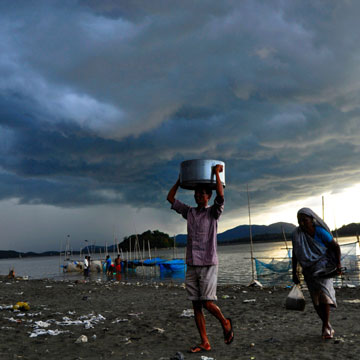 New Delhi:
New Delhi: In news that could bring relief to parched regions of the country, the Indian Meteorological Department (IMD) on Tuesday forecast an 'above normal' Monsoon in 2016.
Releasing the Monsoon forecast for the season, IMD director-general Laxman Singh Rathore told a press briefing that the Monsoon this is year is going to be above normal.
“More or less, Monsoon 2016 is expected to be good,” Rathore stated.
"Monsoon will be 106 percent of the long period average (LPA). There is 94 percent probability that Monsoon will be normal to excess this year. By and large, there will be fair distribution of Monsoon across the country. But Northeast India and South-East India, particularly Tamil Nadu, may get slightly less than normal rainfall," he said.
Drought-hit Marathwada is also likely to receive "good" rainfall, Rathore added.
He, however, stated that temperatures before the onset of Monsoon are going to be above normal.
An above-average Monsoon would ease fears over agriculture and economic growth after two straight droughts hit rural incomes and farm output.
Agriculture, which contributes 15 percent to India's GDP and employs about 60 percent of the country's population, is heavily dependent on the Monsoon as only 40 percent of the cultivable area is under irrigation.
Due to poor Monsoon in 2015-16 crop year (July-June), 10 states have declared drought and the Centre has sanctioned relief package of about Rs 10,000 crore to help farmers.
The Monsoon rains are expected to be above average as the El Nino weather pattern, which can lead to dry spells in South Asia, is gradually fading and giving way to La Nina.
Anything less than 90 percent of the LPA is termed as a "deficient" Monsoon and 90-96 percent of the LPA is considered as "below normal". Monsoon is considered as "normal" if the LPA is between 96-104 percent of the LPA.
"Above normal" Monsoon is between 104-110 per cent of the LPA and anything beyond 110 per cent of the LPA is considered as "excess".
Predictions of a normal monsoon are received with great relief by economists. Former RBI Governor D Subbrao once stated that even the RBI chases the monsoon and the reasons are not hard to find.
Drought has affected several states this year: Andhra Pradesh, Haryana, Gujarat, Karnataka, Madhya Pradesh, Maharashtra, Telangana, Rajasthan and Uttar Pradesh are all reeling under drought. At an all India level, water levels in major dams are at a mere 27 per cent of their capacity: The 91 major reservoirs held 43.394 billion cubic metres (BCM) of water as of March 17, which was 30 per cent less than the 61,878 BCM at this time last year, according to the Central Water Commission, and way lower that the 10-year average of 58.710 BCM.
The story is the same everywhere, says Indira Khurana, a researcher with Global Resource Footprint.
She says a visit to village Sarkhedi in Talbehat block of Lalitpur district, Uttar Pradesh is no different from other villages in the block. Most of the villagers are old, with a sprinkling of a few middle-aged women and young children. Crops have wilted and wells and other water sources are dry. There is no money and no work. Water here is a mirage. The able-bodied men have migrated in search of labour work to nearby cities.
Stories of struggles abound. In villages in Madhya Pradesh for instance, Children are precariously lowered into wells to capture every last drop. Pregnant women in Telangana work miles to get a pot of water which they carry back on their head putting their pregnancy and unborn child at great risk.
It is now April and the monsoon is yet to arrive. When there is scant water, there are few jobs. And when there is no water, there is mayhem. Already alarm bells are clanging.
Tikamgarh, Madhya Pradesh: The president of the Tikamgarh municipality in Madhya Pradesh is forced to employ armed guards against water theft. The purpose is to deter farmers from neighbouring Uttar Pradesh from 'stealing' from the municipality's only source of drinking water. The four local guards are armed with licensed full-length and sawed-off 0.315 bore rifles.
Latur, Maharashtra: As a preventive measure against riots, people gatherings near water sources in this district in Marathwada region are banned. No more than five people are allowed at wells and public storage tanks for the next two months. After all, thirst can lead to frayed tempers and short fuses.
Thiruvanathapuram, Kerala: The model code of conduct has kicked in after the announcement of the state elections. This has affected tanker water distribution to rural parts of the district. The tri-weekly appearance of the tanker has now reduced to a sight once in 12 days. The current chief minister plans to approach the courts.
With no water for their crops and so no money the youth have migrated. Says one wizened villager, "Last I heard my son was working on road works. It has been a while since I have heard from him. How can he send me money if he does not earn enough himself?" he asks.
Water is a perfect blackmail weapon. In February this year, security forces had to take over the Munak Canal as Jat agitators damaged the canal, tightening and virtually strangling water supply to Delhi, affecting Dwarka and other places. Estimates indicate that around 60 per cent of the taps in Delhi ran dry. The Capital, yet again, was vividly shown how its water dependency makes it vulnerable to blackmail. Clearly settlements need to be water independent.
This monsoon forecast brings cheer, and offers a chance to rewrite our destiny. The rains should not go waste: Every raindrop needs to be captured. After all, there is no place in India which does not receive some rain. It's time we did ourselves a favour by respecting the monsoon.
The monsoon will hit India in May end/ early June. Between now and then, all out efforts should be made to revive water conservation structures or build new ones, however small. Whatever raindrop falls must be conserved. India's rich water conservation heritage needs revival perhaps like never before. Over ground and underground water banks must be created.
Funds available through government programmes can help. MGNREGA has assumed great relevance in Bundelkhand, providing much needed employment and therefore money, but also reviving Bundela and Chandela tanks and creating med bandhis. MGNREGA offers great scope for rebuilding the ecology.
Small amounts of money from the general population can also help. Says 2015 Stockholm Water Award winner Rajendra Singh, "The people are in severe distress. Confidence levels have reached rock bottom. People have given up hope. We must stand with them and help them."
Red flags waving from different parts of the country and taken together, tell a story of great thirst with more to follow. It is time to galvanise action. Or else, as a Turkish proverb warns," When one man drinks while another can only water, doomsday follows."
Meanwhile hectic efforts are on to revive the Chandrawal river in Mahoba district of UP Bundelkhand. Will cultivation of the famed mahoba paan, noted for its taste and medicinal value and affected by lack of water be revived? Time will tell.
 New Delhi: In news that could bring relief to parched regions of the country, the Indian Meteorological Department (IMD) on Tuesday forecast an 'above normal' Monsoon in 2016.
New Delhi: In news that could bring relief to parched regions of the country, the Indian Meteorological Department (IMD) on Tuesday forecast an 'above normal' Monsoon in 2016.